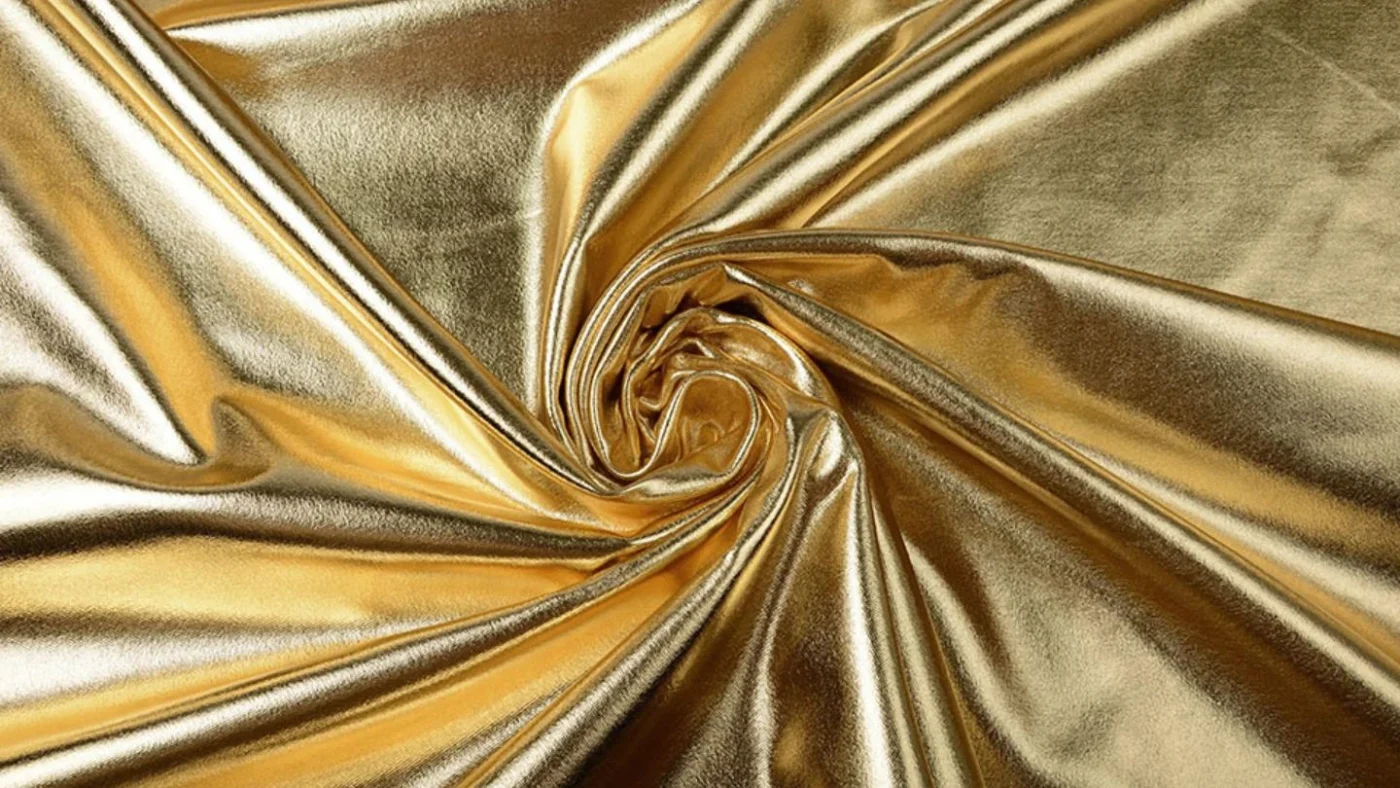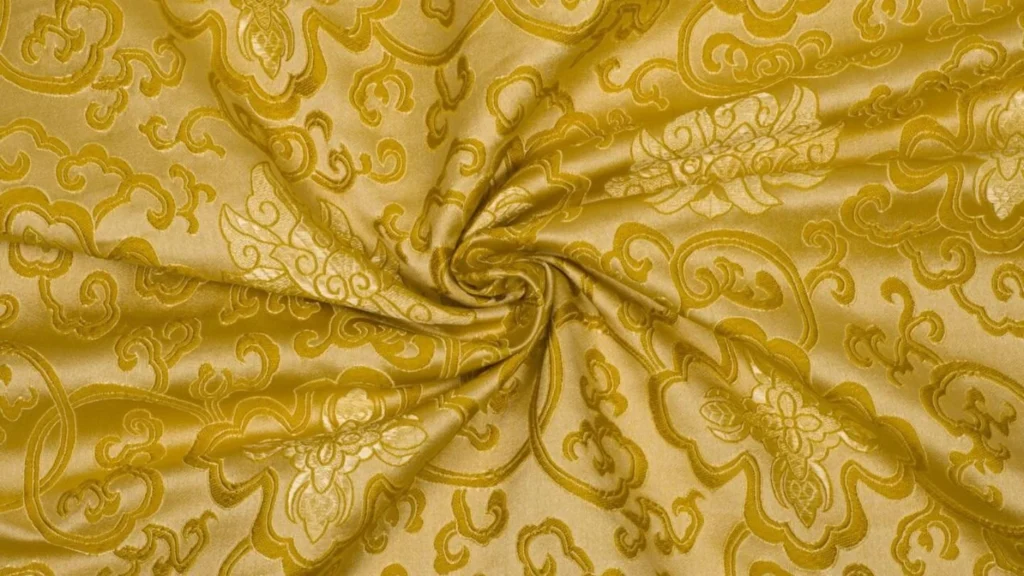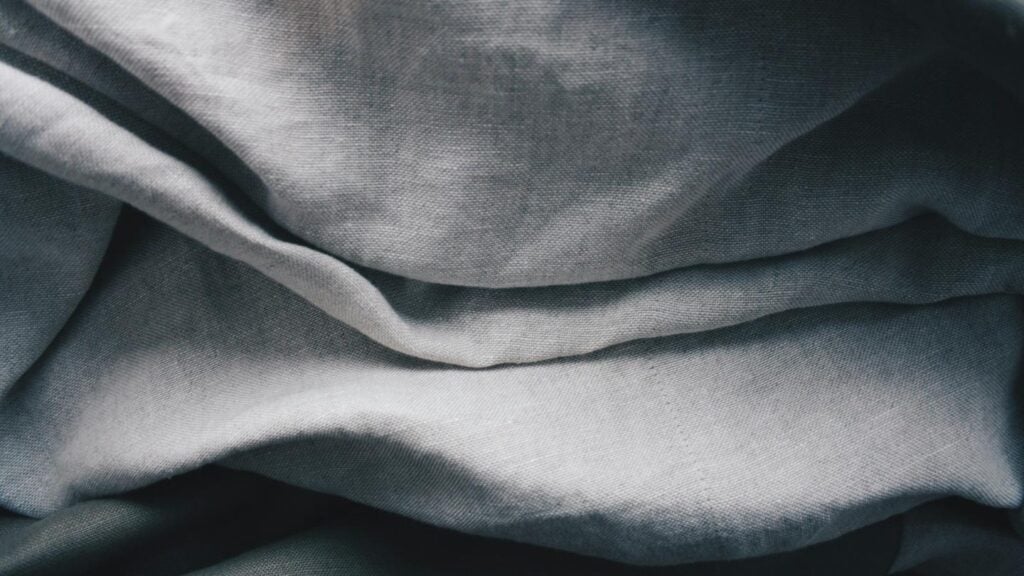2 – Lame Fabric Composition
3 – Lame Fabric vs Other Fabrics
4 – How Lame Fabric Is Manufactured
5 – Common Uses in Fashion
6 – Understanding the Environmental Impact of Lame Fabric
7 – Exploring Price Points and Value for Money
8 – Conclusion
9 – FAQs
What is Lame Fabric?
Lame fabric is a luxurious textile that combines traditional fabric materials with metallic threads, giving it a reflective, shimmering surface. Its name comes from the French word “lamé,” meaning “metal,” which perfectly describes its striking, glossy appearance. Lame fabric is created by weaving metallic yarns—often made from aluminum, gold, or silver—into a textile base, such as silk, polyester, or nylon. This fusion results in a fabric that catches and reflects light, creating a dazzling effect.
Known for its glamorous look and eye-catching texture, Lame fabric is commonly used in high-fashion garments, evening wear, and costumes for stage performances. It is especially popular in luxury fashion for its ability to add sophistication and elegance to dresses, gowns, and accessories. Despite its metallic shine, Lame fabric maintains the softness and flexibility of its base fibers, allowing for stylish yet comfortable designs.
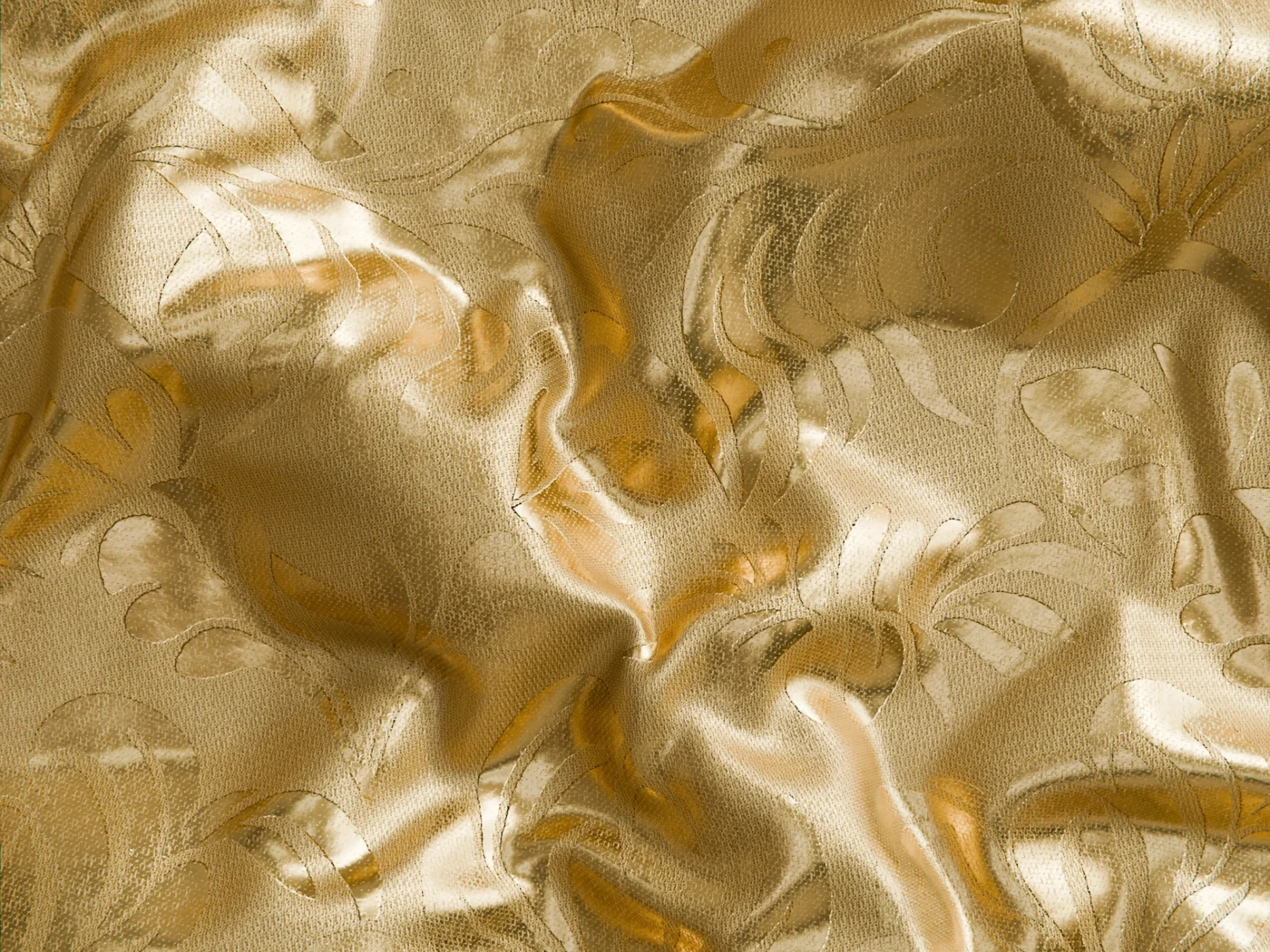
Key Features of Lame Fabric:
- Shiny, metallic appearance: The signature reflective surface is achieved by weaving metallic threads into the fabric.
- Versatility: Can be made from various fibers, including silk, polyester, and nylon, each affecting its feel and durability.
- Luxury appeal: Often used in high-end fashion for evening gowns, stage costumes, and accessories.
- Lightweight yet structured: The fabric retains a certain stiffness due to the metallic threads, which helps it hold its shape.
While Lame fabric is known for its striking visual appeal, it also offers a unique combination of elegance and functionality in fashion. In the following sections, we will dive into its origin, composition, and properties to provide a deeper understanding of this eye-catching material.
Lame Fabric Composition
The composition of Lame fabric is what gives it its signature reflective quality. At its core, Lame is a blend of metallic fibers and traditional textile fibers, which come together to create a material that is both visually striking and functional. The metallic threads used in Lame can vary, but they are often made from materials like aluminum, gold, or silver. These threads are woven or knitted into the base fabric, allowing the metallic shine to permeate the material without compromising the base fabric’s texture.
Key Components of Lame Fabric:
- Metallic Threads:
These are the defining feature of Lame fabric. Aluminum is commonly used because of its lightweight and reflective properties, but gold or silver can also be used for a more luxurious appearance. The metallic threads provide the fabric with its iconic shine, making it stand out in evening wear and special occasion clothing. - Base Fibers:
The base of Lame fabric can be made from a variety of fibers depending on the desired effect. Common fibers include:- Silk: Offers a luxurious, soft feel with a natural sheen.
- Polyester: A more affordable option that provides durability and easy care while still allowing the metallic threads to shine.
- Nylon: Often used for lightweight, flexible Lame fabrics that can be used in clothing that needs to hold its shape.
- Blends:
Lame fabric can also be blended with other fibers like cotton, wool, or spandex for added strength, comfort, and elasticity. These blends can soften the fabric, making it more wearable for daily fashion, while still retaining the stunning metallic finish.
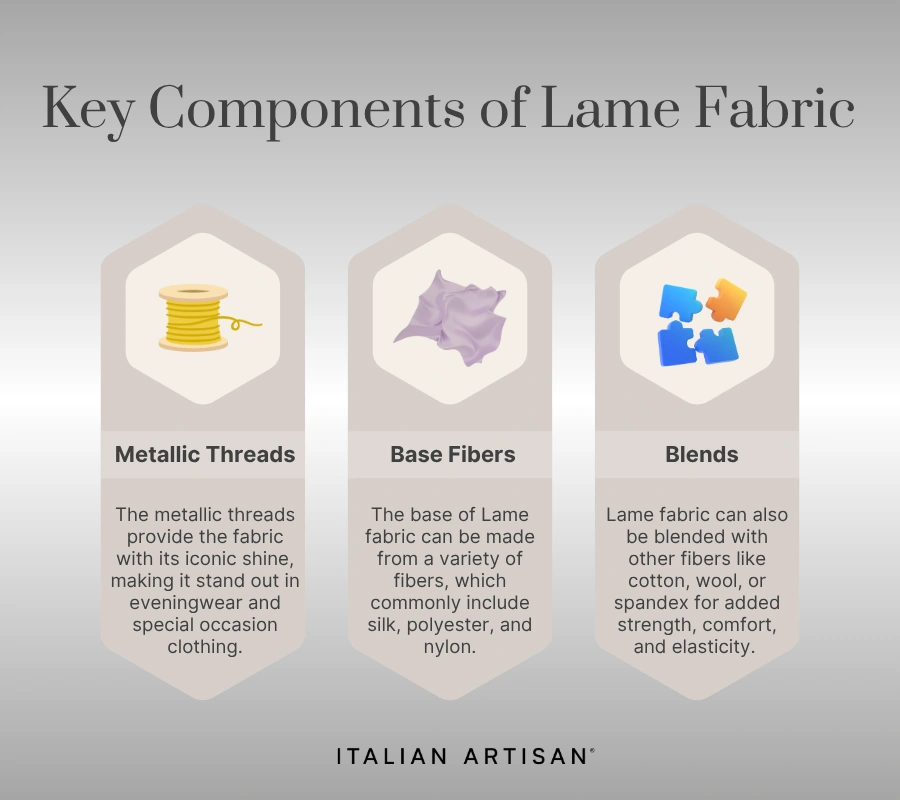
How Composition Affects Performance:
- Shine and Reflectivity: The metallic threads ensure that Lame fabric catches light, making it perfect for evening or formal wear.
- Flexibility: The choice of base fibers like polyester or silk determines how soft and flexible the fabric is, balancing the rigidity of the metallic threads.
- Durability: Polyester and nylon blends can make the fabric more durable, while silk-based Lame may be more delicate but offers a more luxurious feel.
Overall, the composition of Lame fabric allows it to be a versatile material, combining the elegance of metallic shine with the comfort and flexibility of traditional fibers. In the next section, we will explore how Lame fabric compares to other similar fabrics, like brocade and satin.
Lame Fabric vs Other Fabrics
Lame fabric stands out for its metallic finish, making it ideal for luxury fashion and special occasion wear. But how does it compare to other popular fabrics like brocade, velvet, and satin? Let’s break down the key differences:
Lame Fabric vs Brocade
- Brocade: Known for its intricate patterns woven into the fabric, brocade is often made from silk or satin and is used for rich, formal garments.
- Lame Fabric: Lame is more reflective and shiny due to metallic threads like aluminum or gold, offering a more uniform shine rather than patterned texture.
- Key Difference: Lame is more shiny and metallic, while brocade features woven patterns and is usually heavier.
Lame Fabric vs Velvet
- Velvet: A soft, plush fabric made from silk, cotton, or synthetics, velvet has a rich texture but lacks the metallic sheen of Lame.
- Lame Fabric: Provides a high-shine, metallic finish, which makes it ideal for showy designs like evening gowns and performance costumes.
- Key Difference: Lame has a metallic shine and reflective quality, whereas velvet is known for its soft, rich texture.
Lame Fabric vs Satin
- Satin: Satin is a smooth, glossy fabric made from materials like silk or polyester. It reflects light but doesn’t have the metallic finish of Lame.
- Lame Fabric: While both fabrics have a glossy appearance, Lame features a more intense, metallic shine, making it suitable for standout, glamorous pieces.
- Key Difference: Satin offers soft gloss, while Lame has a bold, metallic shine.

How Lame Fabric Is Manufactured
The process of creating Lame fabric involves a combination of traditional weaving techniques and the integration of metallic threads. This unique manufacturing method results in a textile that is both reflective and luxurious, making it ideal for high-fashion garments and accessories.
Key Steps in Manufacturing Lame Fabric:
- Metallic Thread Preparation
The first step in creating Lame fabric is preparing the metallic threads. These threads are typically made from aluminum, gold, or silver, and are often coated with polyester to make them more flexible and durable. The metallic threads are then treated to ensure they can withstand the weaving process without losing their shine. - Weaving or Knitting
The metallic threads are woven or knitted into the base fabric, which could be made from silk, polyester, nylon, or other fibers. The weaving process involves intertwining the metallic threads with the base fibers in a way that allows the fabric to hold its shape while reflecting light. - Bonding or Coating
In some cases, the metallic threads may be coated or bonded with additional layers to enhance their appearance or durability. This coating can help the metallic threads remain intact, ensuring that the shine and reflectivity of the fabric are preserved over time. - Finishing Touches
Once the fabric is woven or knitted, it undergoes finishing treatments such as dyeing, softening, or texturing to ensure the fabric meets the desired color and feel. The metallic threads are carefully examined to make sure they reflect light in a consistent, uniform way. - Quality Control
The final fabric is subjected to rigorous quality control checks to ensure the metallic threads are securely woven and that the fabric maintains its reflective shine. This ensures the fabric is both durable and visually appealing, especially for use in high-end fashion.

Key Benefits of the Manufacturing Process:
- Durability: The bonding of metallic threads helps prevent them from breaking or wearing off over time.
- Consistent Shine: The careful integration of metallic threads ensures the fabric maintains its glossy, reflective appearance.
- Flexibility: The combination of metallic and traditional fibers allows Lame fabric to maintain flexibility while offering a luxurious look.
This unique manufacturing process results in Lame fabric’s signature look and feel—luxurious, durable, and eye-catching. In the next section, we’ll look at common uses of Lame fabric in the fashion industry.
Produce your fashion collection with us
Common Uses in Fashion
Lame fabric is highly valued in the fashion world for its luxurious shine and metallic finish, making it perfect for special occasions, high-end fashion, and statement pieces. Its ability to reflect light and add glamour to any design has made it a favorite for designers creating standout garments.
Popular Applications of Lame Fabric:
- Eveningwear and Gowns
Lame fabric is often used in evening gowns, cocktail dresses, and red carpet attire. Its dazzling metallic shine makes it perfect for making a statement at formal events. - Stage and Performance Costumes
Due to its reflective quality, Lame fabric is commonly used in stage costumes and dance wear. Its ability to catch light under stage lighting makes it ideal for performances where visibility and sparkle are key. - Luxury Accessories
Lame is often used in luxury accessories like scarves, clutches, and shoes. The fabric’s unique appearance elevates any accessory, making it perfect for high-fashion collections. - Outerwear
Designers use Lame fabric in jackets and coats for those who want to make a bold fashion statement. It’s often used in metallic bomber jackets or shiny outerwear, giving them an edgy, glamorous touch. - Bridal Wear
Some bridal designers incorporate Lame fabric into wedding gowns, especially for those looking for a contemporary, shimmering effect. The fabric’s shine adds a modern twist to classic bridal styles.

Why Choose Lame Fabric in Fashion?
- Shine and Reflection: Its metallic finish makes it stand out in evening wear and special event attire.
- Luxurious Feel: The combination of metallic threads and fabric ensures a soft, yet durable texture.
- Versatility: Lame fabric is suitable for a wide range of garments, from formal dresses to performance costumes.
The reflective quality of Lame fabric makes it an excellent choice for anyone looking to add an element of glamour and luxury to their wardrobe. In the next section, we’ll explore the environmental impact of Lame fabric and its sustainability.
Understanding the Environmental Impact of Lame Fabric
While Lame fabric offers luxurious shine and elegance, its environmental impact stems from the use of metallic threads and synthetic fibers like polyester, which are not biodegradable. The production of metallic threads, often from aluminum or silver, can be energy-intensive and harmful to the environment.
Key Environmental Concerns:
- Metallic Threads: The production of metallic fibers involves mining and energy consumption.
- Polyester Base: Polyester, often used in Lame fabric, contributes to microplastic pollution and is non-biodegradable.
Sustainable Solutions:
- Eco-friendly fibers like organic cotton or bamboo can be used as bases to reduce environmental impact.
- Recycled materials (such as recycled polyester) can make Lame fabric more sustainable.

Though Lame fabric has some environmental challenges, advancements in sustainable production methods, such as using recycled materials, are helping to reduce its footprint.
Exploring Price Points and Value for Money
Lame fabric is a luxury material, and its price varies based on factors like the type of metallic threads, the base fabric, and the manufacturing process.
Key Price Factors:
- Metallic Threads: The cost of gold, silver, or aluminum threads can add to the price.
- Base Fabric: Silk Lame is more expensive than polyester-based Lame.
- Manufacturing: The intricate weaving and bonding process also increases the cost.
Value for Money:
- Durability: Despite its higher cost, Lame fabric offers long-term value in luxury fashion and special occasions.
- Affordable Options: Polyester blends offer a more affordable alternative while maintaining a similar aesthetic.
Overall, Lame fabric provides excellent value for its luxury, durability, and performance in high-end fashion.
Conclusion
Lame fabric is a luxurious, shiny material created by combining metallic threads with traditional fibers. It’s ideal for evening wear, performance costumes, and high-fashion due to its striking appearance. While it may be more expensive, its durability and visual appeal make it a great investment for special occasions.
As demand for sustainable fashion grows, eco-friendly alternatives to Lame are emerging, making it a more environmentally conscious choice.
FAQs
1. What is Lame fabric?
Lame fabric is a luxurious material made by weaving metallic threads into traditional textiles, giving it a shiny, reflective surface.
2. What is Lame fabric used for?
Lame fabric is commonly used in evening wear, costumes, luxury accessories, and performance outfits for its glamorous, metallic shine.
3. How is Lame fabric made?
Lame is made by incorporating metallic threads (such as aluminum or gold) into a base fabric like silk or polyester through a weaving or knitting process.
4. Is Lame fabric expensive?
Yes, Lame fabric tends to be more expensive, particularly when made from silk, due to the cost of the metallic threads and the specialized manufacturing process.
5. Can Lame fabric be machine-washed?
Lame fabric requires careful handling. It’s usually recommended to dry clean or hand wash it to maintain its sheen and avoid damaging the metallic threads.
6. How does Lame fabric compare to other shiny fabrics like satin?
While both have a shiny appearance, Lame fabric is more reflective and metallic, whereas satin has a softer, smoother shine.
7. Is Lame fabric eco-friendly?
Lame fabric is not inherently eco-friendly due to its use of metallic threads and synthetic fibers, but more sustainable alternatives and processes are emerging.
8. Is Lame fabric durable?
Yes, Lame fabric is durable, especially when made with synthetic blends, but it requires careful maintenance to retain its appearance.
9. Can Lame fabric be used for everyday wear?
While Lame is typically used for special occasions and high-fashion, lighter blends can be used for casual pieces like tops or accessories.
10. Does Lame fabric lose its shine over time?
If properly cared for, Lame fabric retains its shine. However, wear and tear or improper cleaning may affect its reflective quality.

